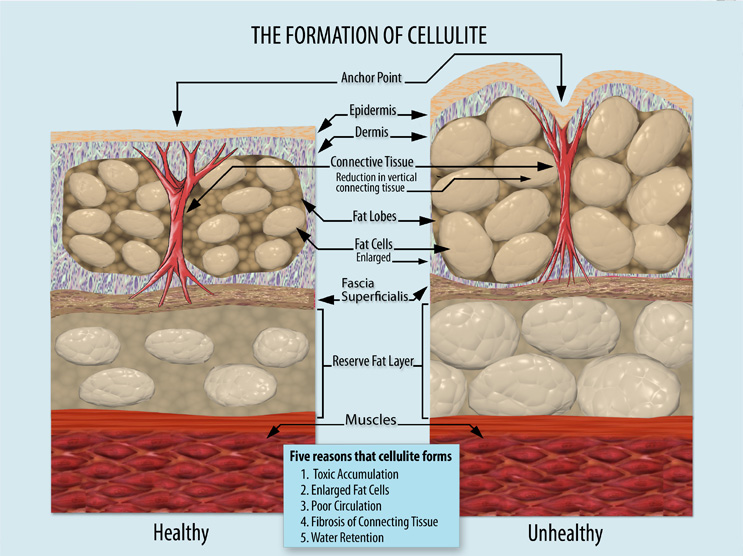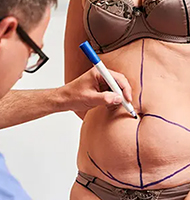Read more about cellulite
Cellulite is a condition in which the skin appears to have areas with underlying fat deposits, giving it a dimpled, lumpy appearance. It is also known as adiposis edematosa, dermopanniculosis deformans, status protrusus cutis, and gynoid lipodystrophy in the medical field.
Cellulite is enlarged pockets of fat that are pushed towards the skin’s surface by tight, inflexible connective tissue. It’s a problem that plagues even thin women.
Cellulite is thought to occur in 80-90% of post-adolescent females. There appears to be a hormonal component to its presentation.
In women, the dermis reaches its maximal thickness at 30 years of age. The dermis area, which is bound together by the connective tissue starts to get looser, due to the aging process of the collagen and elastic fibers.
This allows for more adipose cells to protrude into the dermis area, accentuating the sight of cellulite. In addition, an increased deposition of subcutaneous body fat may often reflect a lifestyle of less exercise and changes in dietary consumption.
It is rarely seen in males, but is more common in males with androgen-deficient states, such as Klinefelter’s syndrome, hypogonadism, postcastration states and in those patients receiving estrogen therapy for prostate cancer. The cellulite becomes more severe as the androgen deficiency worsens in these males.
Since the subcutaneous fat tissue structure is gender-typical to females, the question should actually be is fat deposition hereditary. Although the exact percentage is not fully clarified in the research, there is a meaningful hereditary component to fat deposition.

What causes cellulite?
The causes of cellulite are not well understood, but there are several theories that have been put forth as explanations.
Among these are:
Hormonal factors
Hormones play a dominant role in the formation of cellulite. Estrogen may be the important hormone to initiate and aggravate cellulite. However, there has been no reliable clinical evidence to support such a claim.
Other hormones, including insulin, the catecholamines adrenaline and noradrenaline, thyroid hormones, and prolactin, are all believed to participate in the development of cellulite.
Genetics
Certain genes are required for cellulite development. Genes may predispose an individual to particular characteristics associated with cellulite, such as gender, race, slow metabolism, distribution of fat just underneath the skin, and circulatory insufficiency.
There is a genetic element in individual susceptibility to cellulite. Researchers have traced the genetic component of cellulite to particular polymorphisms in the angiotensin converting enzyme (ACE) and hypoxia-inducible factor 1A (HIF1a) genes.
Diet
People who eat too much fat, carbohydrates, or salt and too little fiber are likely to have greater amounts of cellulite. Lifestyle factors – cellulite may be more prevalent in smokers, those who do not exercise, and those who sit or stand in one position for long periods of time.
Predisposing factors
Several factors have been shown to affect the development of cellulite. Sex, race, biotype, distribution of subcutaneous fat, and predisposition to lymphatic and circulatory insufficiency have all been shown to contribute to cellulite.
Hereditary Factor
Since the subcutaneous fat tissue structure is gender-typical to females, the question should actually be is fat deposition hereditary. Although the exact percentage is not fully clarified in the research, there is a meaningful hereditary component to fat deposition.
Lifestyle
A high-stress lifestyle will cause an increase in the level of catecholamines, which have also been associated with the evolution of cellulite. Certain dieting practices can also diminish the level of these chemicals, and decreasing body fat typically results in the reduction in appearance of cellulite.

What are grades of cellulite?
Cellulite is often classified using three grades:
- Grade I cellulite sees no clinical symptoms, but a microscopic examination of cells from the area detects underlying anatomical changes.
- Grade II cellulite requires the skin to show pallor (pastiness), be lower temperature, and have decreased elasticity, in addition to anatomical changes noted by microscopic examinations.
- Grade III cellulite has visible roughness of the skin (like an orange peel) along with all grade two signs.
Although cellulite can affect both sexes, it is much more common in females, mainly because they are more likely to have particular types of fat and connective tissue.
How can cellulite be treated?
There are several affective therapies which can treat and improve the apperance of cellulite. However, cellulite is not a skin condition which can be resolved by using creams to tone and tighten the skin.
At our Clinic we pride ourselves in offering unique advanced cellulite treatments including the revolutionary Cellulaze Laser, SmoothShapes Laser and Velashape radio frequency, which all have evidence-based proven, safe and outstanding long lasting results.
Cellulaze Laser is the World’s First Aesthetic Laser with minimally invasive surgical approach to treat cellulite beneath the surface of the skin for the long-term reduction of cellulite.
The Cellulaze laser is designed to diminish the lumpy pockets of fat, release the areas of skin depression and increase the elasticity and thickness of the skin. Usually patients require just one treatment.
The Cellulaze Laser system has a solid state Nd: YAG emitting light in the 1440-nm wavelength.
As Dr Ayham Al-Ayoubi explains: “Effective cellulite treatment means addressing the three structural causes of cellulite: fibrous septae, bulging pockets of fat and the natural thinning of the skin that occurs with aging.”
Cellulaze Laser treatment employs the 1440-nm wavelength along with the proprietary Sidelight 3D fiber, which directs laser energy precisely where needed to achieve long-lasting, effective results.
To find out more about the Cellulaze Laser treatment, click here
An other option is VelaShape– the first and only non-surgical FDA-cleared medical device for the Body Reshaping and Cellulite Treatment.
VelaShape has combined energies known as Elos which target and heat fatty tissues within the cellulite treatment area. In addition, the vacuum and tissue manipulation evens out the skin affected by cellulite to reveal a smoother, tighter figure.
VelaShape is the only proven device with breakthrough results as it treats both the deeper tissue and the upper layers of the skin with cellulite. This results in a measurable reduction in fat layers, circumference and the appearance of cellulite.
Velashape is one of the proven devices with breakthrough results as it treats both the deeper tissue and the upper layers of the skin with cellulite giving an outstanding result in cellulite reduction which will be most apparent 6-8 weeks following the Velashape course of treatment sessions.
Smoothshape Laser
Smoothshape is a new Combined Laser and Radio Frequency treatment offered at our clinic.The SmoothShapes XV device treats cellulite by combining continuous wave diode laser and light energy along with mechanical manipulation with vacuum and massage.
There are several other therapies that have been suggested to treat and improve the apperance of cellulite, but none have been supported in the scientific or medical literature, such tharapies include:
- pneumatic massages
- massages that stimulate lymphatic flow
- heat therapy
- ultrasound
- magnetic therapy
- endermologie
- electrical stimulation
Unfortunately, none of these above methods have been scientifically proven to work.
A second class of cellulite treatment strategies consists of drugs that are supposed to act on fatty tissues. There is a wide range of pharmacological agents which are used to try to get rid of cellulite, including:
- Methylxanthines (caffeine and theobromine)
- Pentoxifylline
- Beta-agonists and adrenaline
- Alpha-antagonists
- Amino acids
- Ginkgo biloba
- Rutin
- Indian chestnut
People with cellulite have tried to apply these agents topically, orally, or by injection, but none have been proved effective.
Compression Garments
Some people with cellulite wear special clothing called compression garments to reduce the appearance of cellulite. These garments try to compress arteries and increase blood and lymph flow to reduce visual cellulite.
Cellulite reduction techniques such as liposuction and dieting actually do not remove cellulite. However, eating a healthy, balanced diet and exercising may be the best way to reduce the fat content in cells and reduce the appearance of cellulite.
How can cellulite be prevented?
Eating healthy, low fat foods such as fruits, vegetables, and fiber can help to some dgree to reduce the bad apperance of cellulite. Similarly exercising regularly, maintaining a healthy weight, and reducing stress are recommended.
History of cellulite
The term ‘cellulite’ was first used in the 1920s, and began appearing in English language publications only in the late 1960s, with the earliest reference in Vogue magazine and very rapidly the word cellulite has suddenly crossed the Atlantic.
Its existence as a real disorder has been questioned and the prevailing medical opinion is that it is merely the “normal condition of many women”.














































